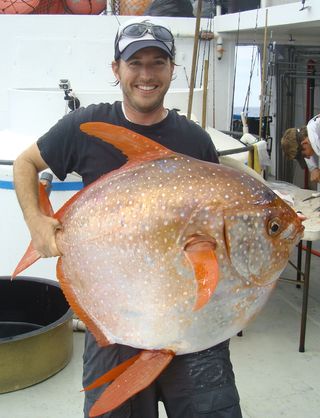How Do Cold Blooded Animals Keep Warm
First Warm-Blooded Fish Found

Updated at 4:01 p.m. ET, Fri, May 15.
The car-tire-size opah is striking enough cheers to its rotund, silver body. But now, researchers have discovered something surprising about this abyssal dweller: It's got warm blood.
That makes the opah (Lampris guttatus) the first warm-blooded fish ever discovered. Most fish are ectotherms, pregnant they require heat from the environment to stay toasty. The opah, as an endotherm, keeps its ain temperature elevated even as information technology dives to chilly depths of 1,300 feet (396 meters) in temperate and tropical oceans around the world.
"Increased temperature speeds up physiological processes within the body," study leader Nicholas Wegner, a biologist at the National Oceanic and Atmospheric Administration (NOAA) Fisheries' Southwest Fisheries Science Middle in La Jolla, California, told Live Science. "As a consequence, the muscles can contract faster, the temporal resolution of the centre is increased, and neurological transmissions are sped up. This results in faster pond speeds, ameliorate vision and faster response times."
The issue, Wegner said, is a fast-pond fish with an reward for hunting irksome, cold-blooded prey. [See Photos of the Gigantic Warm-Blooded Opah (Moonfish)]
Undersea moon
The opah, also known as the moonfish, has relatively small red fins decorating its large, round torso, which tin can grow upward to 6 feet (1.8 meters) long. These fins, which flap rapidly equally the fish swims, plough out to be of import in generating body heat for the opah.
"The opah appears to produce the majority of its heat by constantly flapping its pectoral fins which are used in continuous swimming," Wegner said.
Researchers first suspected that something might be strange nigh the opah after analyzing a sample of the fish's gill tissue. According to the new study, published today (May xiv) in the journal Scientific discipline, the claret vessels in the tissue are gear up so that the vessels carrying cool, oxygenated blood from the gills to the body are in contact with the vessels carrying warm, deoxygenated claret from the body to the gills. As a result, the outgoing blood warms up the incoming blood, a procedure called counter-current heat substitution.
"There has never been anything like this seen in a fish'southward gills before," Wegner said in a argument. "This is a cool innovation by these animals that gives them a competitive edge. The concept of counter-current heat exchange was invented in fish long before [humans] idea of information technology."
To confirm that these special gills helped the opah stay toasty, the researchers tagged a number of moonfish with temperature monitors and tracked the fish as they dove. The fish spend near of their time at least 150 anxiety (45 m) beneath the sea surface. No thing how deep they dive, even so, their body temperature stays well-nigh 9 degrees Fahrenheit (five degrees Celsius) warmer than the surrounding water. Fat deposits around the gills and muscles assistance insulate the fish, the researchers establish.
Built for speed
Warm blood gives deep-body of water fish a boost, according to Wegner. The opah's muscles and nervous system likely function faster than an equivalent fish with cold blood. Other deep-diving fish, such as tuna and some sharks can shunt claret to sure torso parts to keep them warm during deep dives. Merely these fish accept to swim up out of the depths frequently to forbid their organs from shutting down.
In contrast, the opah can stay deep for long periods of time.
"Nature has a way of surprising u.s. with clever strategies where yous to the lowest degree await them," Wegner said in a argument. "Information technology's hard to stay warm when you're surrounded past cold water, but the opah has figured it out."
Next, Wegner told Alive Scientific discipline, he and his colleagues want to written report Lampris immaculatus, the opah's southern cousin. This fish, the southern opah, lives in colder waters than the northern opah, then it would be harder to keep warm, Wegner said — but even more than benign.
Editor'due south Note: This story was updated to state that most fish are "ectotherms" and not "exotherms" as information technology was written.
Follow Stephanie Pappas on Twitter and Google+ . Follow us @livescience , Facebook & Google+ . Original article on Alive Science.
Source: https://www.livescience.com/50839-first-warm-blooded-fish-found.html
Posted by: hurstdreir1946.blogspot.com


0 Response to "How Do Cold Blooded Animals Keep Warm"
Post a Comment